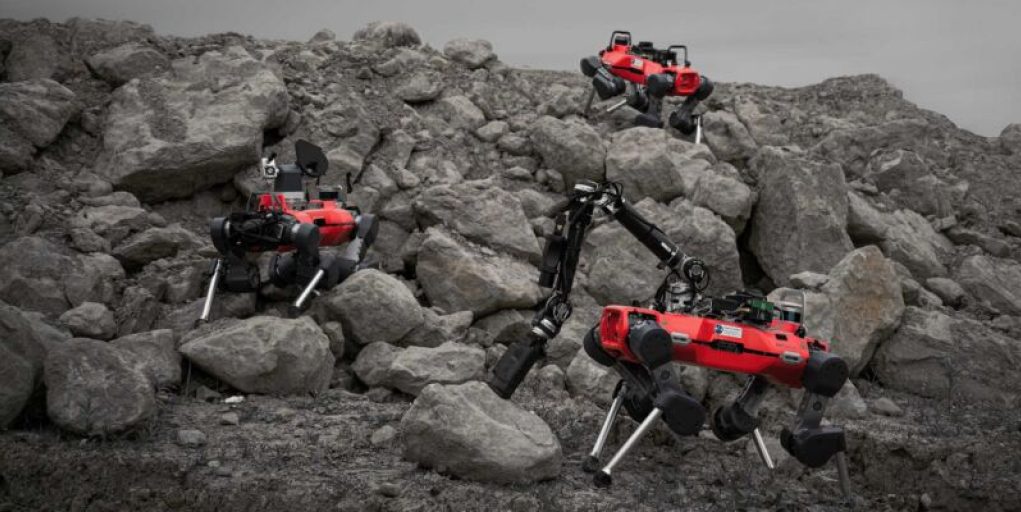While rovers have made incredible discoveries, their wheels can hold them back, and erratic terrain can mean damage. But what if they had a leg up? Enter a small swarm of four-legged robots that could assist future rovers and mitigate the risk of damage. These robots, known as ANYmals, were customized by researchers at ETH Zurich to resemble giant metal insects. They were tested in environments that closely resemble the harsh lunar and Martian terrain. Not only can these bots literally step over obstacles with their legs, but they also work most efficiently as a team. Each robot is specialized for specific functions but flexible enough to cover for each other if one malfunctions.
According to a study recently published in Science Robotics, the ETH Zurich team designed each of the three semi-autonomous bots to work both independently and together. While they have distinct features, they also share some hardware and software capabilities. The redundancy in their design ensures that if one robot encounters trouble, the remaining two can back it up while still utilizing their specialized features.
The robots were put to the test in environments similar to the surface of the Moon and Mars as part of the ESA/ESRIC Space Resources Challenge. They explored areas such as craters, boulders, loose regolith, and hardened lava beds. The data they collected was sent back for further analysis by human scientists.
The researchers aim to continue upgrading these legged robots to achieve complete autonomy, allowing them to operate and reallocate tasks on their own. This would improve their scalability for more challenging missions, such as Mars exploration.
In the future, legged robots could join rovers and airborne spacecraft, enabling exploration in treacherous regions that rovers cannot access. With teamwork, the possibilities for space exploration are endless.
Science Robotics, 2023. DOI: 10.1126/scirobotics.ade9548 (About DOIs).
Elizabeth Rayne is a creature who writes. Her work has appeared on SYFY WIRE, Space.com, Live Science, Grunge, Den of Geek, and Forbidden Futures. When not writing, she is either shapeshifting, drawing, or cosplaying as a character nobody has ever heard of. Follow her on Twitter @quothravenrayne.
NASA scientists have developed a team of robots that they hope will help conduct further research of distant planetary surfaces. Utilizing the elements of advanced robotics technology and artificial intelligence, these robots will be able to traverse, observe and monitor the distant environment and planets like never before.
The team of robots, known as the Astrobotics Wheel and Legged Squad (AWALS), represent the newest development in robotic exploration technology. This is propelled by a partnership between the Japanese Aerospace Exploration Agency (JAXA) and NASA’s Jet Propulsion Laboratory (JPL). Experiments in controlling and maneuvering the robots aimed at providing insight into the robotics technology’s potential for eventual planetary exploration.
Equipped with advanced wheel and leg systems, the AWALS robots will be able to climb and move obstacles in the new planetary environment. While wheels offer a flexible and efficient method of navigating unknown terrain, legs are the best option for obstacle navigation. According to researcher with JAXA, “We continue to make progress on the development of robotic designs for mobility challenges in planetary exploration. These newly designed legged robots and wheeled robots are designed to autonomously explore and traverse previously unknown and challenging terrains on-site.”
Further developments led to the integration of an artificial intelligence (AI) system, allowing the robots to operate independently and understand commands given by scientists. This infrastructure allows the robots to work without the constant presence of a human supervisor, enabling it to operate autonomously. As the artificial intelligence system becomes more sophisticated over time, the AWALS robots are predicted to be able to conduct detailed exploration intelligence of new environments.
The future of exploration technology is exciting with the development of legged and wheeled robots. The Astrobotics Wheel and Legged Squad is a powerful tool for uncovering new regions of the universe and expanding human understanding. With the addition of advanced AI technology, these robots could become the future pioneers of deep space exploration.




















